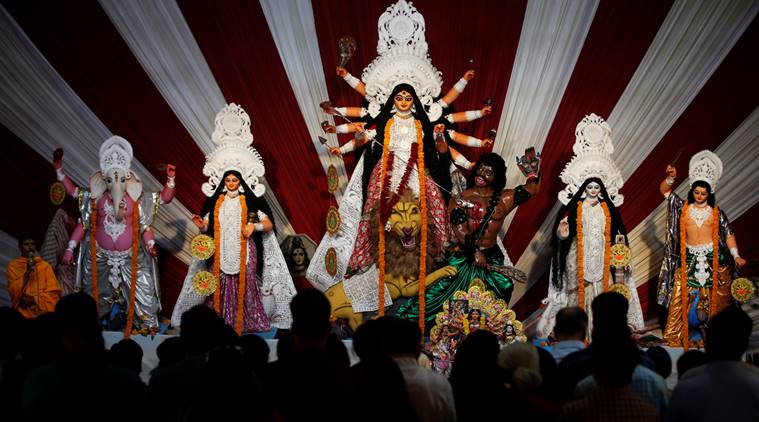Inclusive, Syncretic and Empowering: There is much to celebrate about Durga Puja
From pandals depicting lives of sex workers to a unique tableau made for the visually impaired, Durga Puja is an all-inclusive spectacle, a true symbol of secularism.

Devotees worship the idol of Hindu goddess Durga at a pandal in Ahmedabad. (Source: Reuters)
A mild nip in the air embellished with the fragrance of Harisingar. Vibrant pandals in a riot of festive colours. Carefully handcrafted idols and the typical ‘Chauu’ mask. Painters, artists and sculptors displaying their imagination and creativity, while capturing the Durga Puja spirit. Nau-Durga, Durgotsav, or Durga Puja spans 10 days and is no longer restricted to being a regional spectacle alone. Celebrated across the country and many other continents as well, the multicultural appeal of the festival is best expressed through traditional ‘pandals,’ contemporary tableaux, fusion cuisine and fairs attracting thousands of visitors, tourists and people cutting across economic and social strata.
The secular values of tolerance, regional integration, harmony and peaceful coexistence, make Durga Puja all-inclusive, decentralised and participatory – while celebrating the essence of women empowerment.
Here’s a look at some of the features that make Durga Puja phenomenon that it is.
Demolishing Patriarchy
One of the rare anecdotes popularised by Sanjay Leela Bhansali’s Devdas (2002) and before him, by literature is the sanctity of the clay brought from Sonagachi, Kolkata, which plays a pivotal role during the festival. Known as ‘Punya Maati’ or pure soil, idol-making as a sacred ritual begins by collecting and later mixing clay with the local mud from ‘Kumortoli,’ or the traditional potters’ commune, where the major portion of idol sculpting takes place. This year, one pujo in Sonagachi itself is being organised as an all-woman pujo and has been organised by sex workers. Another, in Ahiritola Jubakbrinda, Kolkata has a 300-foot-long graffiti dedicated to the rights of sex workers and issues of women in trafficking.
At the time when the #Metoo wave is engulfing the country and women are being beaten and not allowed to enter Sabarimala, it is worth remembering how this festival derived from the Shakti tradition symbolises the goddess of power and strength. Seen as the destroyer of evil – with 10 powerful arms carrying weapons – Durga slays the demon, Mahishasura and arrives with much aplomb and glory – riding a lion. The daughter is finally home.
It is important to note that a festival dedicated to the power of the goddess, is all-inclusive, only when women (and men) from all strata of the society, are included in the festivities – as is the case during Durga Puja.
Communal Harmony and Cultural Coexistence
Traditionally, the festival stems from the concept of ‘Sarbojanin’ or ‘belonging to everybody’. A belief which finds resonance in the fact that Muslim Patua and Pattachitra artists in West Bengal and Odisha make these idols. According to a report in The Hindu, in Khidirpur, Kolkata, Durga Puja festival has been jointly organised by Hindus and Muslims for over 70 years now.
Similarly, seasoned Muslim ‘Pattachitra’ artists bring to life vivid Hindu gods and goddesses on scrolls, paintings and through other art forms. According to India Today, 50-year-old Sheikh Salim Niyariya has been organising Puja celebrations in Handi Chowk area in Raigarh for the past 23 years. In Banka Bazar, a cluster of Muslim artisan families have been handcrafting and sculpting idols and pandals every year.
Fusion of Modernism and Tradition
The idea of Durga Puja is cosmopolitan and multicultural because it allows and encourages contemporary and modern variations of idol sculpting and art installations. For instance, back in 1997-98, when Jurassic Park and Titanic released, Durga Puja pandals were made on similar themes. Every year, unique pandal themes dominate celebrations not just in Kolkata, but every major city. In 2016, modern-day taxis, letter boxes, ‘Holi in autumn’ and other fusion themes were just some innovations which could be seen in the pandals.
Similarly, this year, Jairam Youth Sporting Club in Adityapur, Jamshedpur has chosen South Africa as its Durga Puja theme. In a first, the Samaj Sebi Sangha Puja in Ballygunge is enabling the visually impaired to touch and sense the grand spectacle that is Puja. The words “Ma” and “Jai Ma Durga” are written in Braille.
More recently, fusion art forms amalgamating different styles of paintings – Madhubani, Kalighat, Patachitra and other craft forms, are being used to commemorate the Puja. Traditional and international designs from across the world are adding cosmopolitan and contemporary hues to the Puja celebrations.
Religion, caste or creed-based boundaries have no place in the epoch of ‘Vasudhaiv Kutumbkum’ or ‘world is one family’. A belief which not only marks the Durga Puja festivities but can be seen being taken forward every year.
Swasti Pachauri is a social sector professional, formerly working as a Prime Minister’s Rural Development Fellow in Seoni district of Madhya Pradesh.






















No hay comentarios:
Publicar un comentario